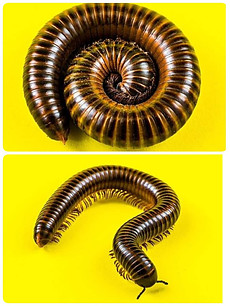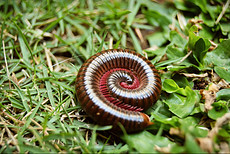
Millipedes don’t pose any threats to humans, but seeing them around your home can be repulsive. Are you tired of seeing millipedes around your home? If this is your situation, then keep reading. You’re about to learn how to eliminate and keep millipedes away from your home.
Getting Rid of Millipedes
1. Kill Any Millipede You Sight
This method is effective because millipedes don’t invade homes in groups; they usually move alone and not in a swarm. Kill any millipede immediately you spot it in your house. You don’t have to capture it and later release it into your garden or yard.
2. Sweep up The Millipede
Some persons are a little bit squeamish about touching or even killing millipedes. If you’d rather not get close to a millipede, simply sweep or vacuum it and dispose of it in a trash can. The trash can should be covered and situated outside your house.
Millipedes dumped in indoor trash can still find their way out into your room. You can also suck millipedes up with a shop vac should you have plenty of millipedes to deal with.
3. Use Sprays on Millipedes
You can also use pest spray on millipedes if you prefer not to touch them with your hands. Different pest control sprays are safe for indoor use, purchase one and spray it directly on them.
The sprays are meant to kill them immediately. Always go through the manufacturer’s instructions to be sure if it is safe to be used around children and pets.
4. Set out a Trap
There are traps designed to catch millipedes, so check the hardware store for such traps. Most millipedes’ traps come with sloped sides and have light to attract millipedes to them.
Essentially, the light is to attract the millipede to get on the trap. Once they get on the trap, they won’t be able to escape due to the sloped sides of the trap.
Using Outdoor Repellents
1. Apply Insecticides within the Border of Your Home
Spray insecticide within the boundary of your home; it should be done in line with the manufacturer’s instructions. Any millipede that steps onto the insecticide will be killed by the chemical.
Read the label on the insecticide to determine the application dosage and how often it should be. Environment and the type of insecticide determine how often it should be applied. For instance, powdered insecticides would be applied often in a wet environment than liquid insecticides.
Always ensure you wear it whenever you’re handling insecticides to prevent skin irritation.
2. Use a millipede Insecticide
Purchase powders or chemical sprays that have either carbaryl, cyfluthrin, bendiocarb, or propoxur. You can get any of these products from a hardware store, local gardening center, or online.
They work well in repelling millipedes. Note that products that contain pyrethroids should rather be sprayed directly on the millipedes than use as a repellent. You can’t do without the manufacturer’s information and warnings; read it before using any product.
3. Apply Boric Acid/Diatomaceous Earth
You can use either of these powder products on the soil around your yard. Sprinkle the powder into the soil at any congregating point of millipedes. Both products work similarly; they dehydrate and kill the millipedes. These products are suitable for cracks or damp spots.
Warning: don’t use any of these products if you have kids or pets around such an area.
4. Treat the Soil
Treat the soil by mixing an outdoor insecticide where the millipedes tend to congregate outside. A common practice is to spread the insecticide on a mulched flower beds. The millipedes in the soil would get poisoned and die eventually.
If you don’t like the chemical method, you can also do it the natural way. Simply mix some quantity of ash from burnt wood with the soil of interest. The wood will help to dry out the soil, which makes the soil unfit for millipedes to breed or lay eggs in it.
5. Hire a Professional
At some point, you may need to get a pest control professional to help you take care of the millipedes. You need a pest control professional if you’re still battling with millipedes’ infestation after you’ve done everything at your disposal.
Although such a service will cost you money, it’s better than having to live with a pest outbreak. Check local listings, read reviews online, or simply ask for recommendations to get a pest control professional.
Preventing Millipede Outbreaks
1. Keep Your Home Dry
Millipedes thrive in a moist environment, so ensure that your home is always dry. Make sure that rainwater is properly diverted away from your house. Check your downspouts and also rid your gutter of blockages that will prevent the flow of water from your house.
You can also use a dehumidifier to keep your home dry. The humidifier will quickly drain out the excess moisture from your yard, making it unattractive for millipedes. If you don’t know how moist your home is, then get a relatively cheap hygrometer to ascertain it.
2. Trim Your Lawn Regularly
Make sure you keep your lawn always trimmed and remove all debris or pile of leaves from the surroundings. If you have any nearby mulch, remove it far from the foundation of your house. Long grass, nearby mulch, and piles of leaves are hiding places for millipedes. Millipedes also love to hide in rocks, boards, compost, and trash piles.
3. Seal All Cracks or Crevices
Check your walls, doors, and windows for any cracks that could lead millipedes into your house and seal it. Use seal cracks, caulking, etc., to block all cracks and to keep millipedes away from your house.
4. Use Chicken as Predator
You can rear chicken in your yard to feed on the millipedes. Make sure your city law allows you to keep chicken at home.
Ensure to check if the law permits it before you try this method. This method is very effective in controlling the population of millipedes because chickens feed on different garden pests, including millipedes.
Conclusion
We’ve covered how to get rid of millipedes in this post. These include killing them instantly on sight, sweep and throw them in a waste bin outside your house, use chemicals or even hire a professional.
Once your yard is free from millipedes, you need to keep the area dry to make it less attractive to them.
Thank you so much for your time reading this article; if you have a question or something you want to share, please leave your comment below, and I’ll be happy to write back to you.

Geoff
Thanks for this useful information.
You certainly have given us plenty of options not only to deal with them but to prevent them from becoming a problem in the first place. Thankfully I only ever see the very odd one, so I don’t have to worry about spraying the area with any chemicals. I can easily dispose of it.
admin
Thank you so much, Geoff!
I appreciate your comment and for stopping by.
Best wishes,
Joyce
Dave
I just love your site – you never know what kind of useful information you will find.
I particularly like several pieces of advice. We live outside the city limits in the county here in TN where you are permitted to have animals like chickens in your yard. Unfortunately, we also have dogs. My son is in a similar situation but has the chickens in an electrified fenced-in area to keep the dogs away. They are very good at all forms of insect control.
I also agree with your advice to keep trees and shrubs away from the house. Because of our dogs, we can’t / don’t use insecticides but have had some success with boric acid as you note.
Plus your site is beautiful! Congratulations.
Dave.
admin
Hello Dave,
Thanks for your comment on How to Get Rid of Millipedes. Yes, I wouldn’t say I like insecticides as I have dogs and cats as well. Boric acid is helped. Thanks.
Joyce